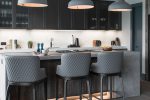When it comes to designing your kitchen cabinets, understanding your kitchen layout is crucial. The layout of your kitchen will determine the placement and size of your cabinets, as well as the overall flow and functionality of the space. There are several common kitchen layouts, including the L-shaped kitchen, U-shaped kitchen, galley kitchen, and open-concept kitchen. Each layout has its own unique challenges and opportunities when it comes to cabinet design.
In an L-shaped kitchen, for example, you may have more corner cabinet space to work with, while a galley kitchen may require more creative storage solutions due to its narrow layout. Understanding how you use your kitchen and the specific challenges of your layout will help you make informed decisions about cabinet placement, storage solutions, and overall design. Taking the time to carefully assess your kitchen layout will ensure that your cabinet design is both functional and aesthetically pleasing.
Understanding your kitchen layout is also important when it comes to maximizing space and creating a cohesive design. By taking into account the size and shape of your kitchen, you can make informed decisions about the placement of appliances, countertops, and other elements that will impact your cabinet design. Whether you have a small, compact kitchen or a spacious open-concept layout, understanding your kitchen’s unique characteristics will help you create a cabinet design that works for your specific needs.
Selecting the Right Materials and Finishes
Selecting the right materials and finishes for your kitchen cabinets is an important decision that will impact both the look and functionality of your space. There are a wide variety of materials to choose from, including wood, laminate, metal, and glass. Each material has its own unique characteristics and benefits, so it’s important to consider factors such as durability, maintenance, and style when making your selection.
Wood is a popular choice for kitchen cabinets due to its timeless appeal and versatility. Hardwood such as oak, maple, cherry, and birch are all popular choices for their durability and natural beauty. Laminate cabinets are another popular option, offering a wide range of colors and finishes at a more affordable price point. Metal cabinets can add a sleek, modern look to your kitchen, while glass-front cabinets can create a light and airy feel.
In addition to selecting the right material, choosing the right finish for your cabinets is also important. Whether you prefer a natural wood finish, a painted look, or a high-gloss sheen, the finish of your cabinets will impact the overall style of your kitchen. It’s important to consider factors such as maintenance, durability, and how the finish will complement other elements in your kitchen, such as countertops and backsplashes.
Ultimately, selecting the right materials and finishes for your kitchen cabinets is a personal decision that should take into account your lifestyle, design preferences, and budget. By carefully considering the pros and cons of each option, you can make an informed decision that will result in beautiful and functional cabinets that enhance your kitchen.
Choosing the Best Cabinet Style for Your Kitchen
Choosing the best cabinet style for your kitchen is an important decision that will impact the overall look and feel of the space. There are several popular cabinet styles to choose from, including traditional, modern, transitional, and rustic. Each style has its own unique characteristics and can be customized to suit your specific design preferences.
Traditional cabinets are known for their timeless appeal and classic details such as raised panels, decorative moldings, and ornate hardware. These cabinets are often made from wood and can create a warm and inviting feel in your kitchen. Modern cabinets, on the other hand, are characterized by sleek lines, minimalist hardware, and a focus on simplicity. These cabinets are often made from materials such as metal or laminate and can create a clean and contemporary look in your kitchen.
Transitional cabinets combine elements of both traditional and modern styles, creating a balanced and versatile look that can work well in a variety of kitchen designs. These cabinets often feature simple, clean lines with some traditional details such as raised panels or decorative hardware. Rustic cabinets are another popular option, known for their natural materials, distressed finishes, and charming details such as beadboard or open shelving.
When choosing the best cabinet style for your kitchen, it’s important to consider factors such as your personal design preferences, the overall style of your home, and how the cabinets will complement other elements in your kitchen such as countertops, backsplashes, and flooring. By carefully considering these factors, you can choose a cabinet style that reflects your personal taste and enhances the overall design of your kitchen.
Considering Storage and Organization Needs
When designing your kitchen cabinets, it’s important to consider your storage and organization needs in order to create a functional and efficient space. There are several factors to consider when it comes to storage and organization, including the size of your kitchen, the number of people using the space, and how you use your kitchen on a daily basis.
One of the first things to consider is the amount of storage space you’ll need for items such as pots and pans, small appliances, pantry items, and cooking utensils. This will help you determine the number of cabinets you’ll need as well as the type of storage solutions that will work best for your specific needs. For example, if you have a large collection of pots and pans, you may want to incorporate deep drawers or pull-out shelves for easy access.
In addition to storage space, it’s important to consider how you’ll organize your items within the cabinets. This may include incorporating features such as adjustable shelves, dividers, pull-out racks, or lazy Susans to maximize space and keep items organized. It’s also important to consider how you use your kitchen on a daily basis in order to create a layout that works for your specific needs.
By carefully considering your storage and organization needs when designing your kitchen cabinets, you can create a space that is both functional and efficient. Whether you have a small galley kitchen or a spacious open-concept layout, taking the time to assess your specific needs will help you create a cabinet design that works for you.
Budgeting for Your Kitchen Cabinet Project
Budgeting for your kitchen cabinet project is an important step in ensuring that you get the cabinets you want at a price you can afford. There are several factors to consider when budgeting for your project, including the size of your kitchen, the materials and finishes you choose, and whether you plan to hire a professional for installation.
One of the first things to consider when budgeting for your kitchen cabinet project is the size of your kitchen. Larger kitchens will require more cabinets and materials, which will impact the overall cost of the project. It’s important to carefully measure your space and consider factors such as ceiling height and any unique architectural features that may impact the design.
The materials and finishes you choose for your cabinets will also impact the overall cost of the project. High-end materials such as hardwood or custom finishes will come with a higher price tag than more affordable options such as laminate or stock finishes. It’s important to carefully consider factors such as durability, maintenance, and style when making your selection in order to find a balance between quality and cost.
Finally, if you plan to hire a professional for installation, it’s important to factor this cost into your budget. While hiring a professional can ensure a high-quality installation, it will also come with an additional cost that should be considered when budgeting for your project. If you plan to tackle installation yourself, it’s important to carefully consider factors such as skill level and time commitment in order to ensure a successful outcome.
By carefully considering these factors when budgeting for your kitchen cabinet project, you can ensure that you get the cabinets you want at a price you can afford. Whether you have a small budget or are willing to invest in high-end materials and finishes, taking the time to carefully plan and budget for your project will help you achieve the kitchen of your dreams.
Hiring a Professional vs. DIY Installation

When it comes to installing new kitchen cabinets, one of the biggest decisions you’ll need to make is whether to hire a professional or tackle the installation yourself. There are several factors to consider when making this decision, including your skill level, time commitment, budget, and overall goals for the project.
Hiring a professional for installation can ensure a high-quality outcome without the stress and time commitment of tackling the project yourself. A professional installer will have the skills and experience needed to properly measure, assemble, and install your cabinets with precision. They will also have access to specialized tools and equipment that can ensure a seamless installation process.
On the other hand, tackling installation yourself can save money and give you a sense of accomplishment in completing the project on your own. However, it’s important to carefully consider factors such as your skill level and comfort with DIY projects in order to ensure a successful outcome. Installing cabinets requires precision and attention to detail in order to ensure that they are level, secure, and properly aligned.
Ultimately, whether you choose to hire a professional or tackle installation yourself will depend on factors such as your budget, skill level, time commitment, and overall goals for the project. If you have limited experience with DIY projects or want to ensure a high-quality outcome without the stress of installation, hiring a professional may be the best option for you. On the other hand, if you have experience with DIY projects and want to save money by tackling installation yourself, it’s important to carefully assess your skills and comfort level before making this decision.
Maintaining and Caring for Your Kitchen Cabinets
Once your new kitchen cabinets are installed, it’s important to take steps to maintain and care for them in order to ensure their longevity and beauty. There are several simple maintenance tips that can help keep your cabinets looking their best for years to come.
One of the most important things you can do to maintain your cabinets is to regularly clean them with a mild soap and water solution. This will help remove dirt, grease, and grime that can build up over time. It’s important to avoid using harsh chemicals or abrasive cleaners that can damage the finish of your cabinets.
In addition to regular cleaning, it’s important to take steps to protect your cabinets from potential damage. This may include using coasters under glasses or dishes to prevent water rings on cabinet surfaces, using cutting boards when preparing food to avoid scratches on cabinet doors or drawers, and using caution when opening or closing cabinet doors in order to avoid damage.
Finally, it’s important to address any issues with your cabinets as soon as they arise in order to prevent further damage. This may include tightening loose hinges or handles, repairing any chips or scratches in the finish, or addressing any issues with drawer slides or door alignment.
By taking these simple maintenance steps on a regular basis, you can ensure that your new kitchen cabinets remain beautiful and functional for years to come. Whether you have traditional wood cabinets or modern laminate finishes, caring for them properly will help protect your investment and keep your kitchen looking its best.



